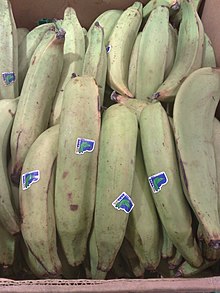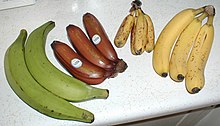Cooking banana
From Wikipedia, the free encyclopedia
| Cooking banana | |
|---|---|

Cooking bananas for sale
| |
| Genus | Musa |
| Species | Musa × paradisiaca |
| Hybrid parentage | M. acuminata × M. balbisiana |
| Cultivar group | Cultivars from a number of groups, including the AAA Group, the AAB Group and the ABB Group |
| Origin | Primary: Southeast Asia, South Asia; secondary: West Africa |
Cooking bananas[1][2][3][4][5] are banana cultivars in the genus Musa whose fruits are generally used in cooking. They may be eaten while ripe or unripe and starchy. Some cooking bananas are also referred to as green bananas[2] or plantains (/ˈplæntᵻn/[6][7]US /plænˈteɪn/,[8] UK /ˈplɑːntᵻn/[6]).
The term "plantain" is loosely applied to any banana cultivar that is eaten when cooked. However, there is no formal botanical distinction between bananas and plantains. Cooking is also a matter of custom, rather than necessity. Ripe plantains can be eaten raw, since the starches are converted to sugars as they ripen. In some countries, there may be a clear distinction between plantains and bananas, but in other countries, where many more cultivars are consumed, the distinction is not made in the common names used.[9] In more formal usage, the term "plantain" is used only for "true" plantains, while other starchy cultivars also used for cooking are called "cooking bananas".[10][11][12]
All modern plantain cultivars have three sets of chromosomes (i.e. they are triploid). Many are hybrids derived from the cross of two wild species, Musa acuminata and Musa balbisiana. The currently accepted scientific name for all such crosses is Musa × paradisiaca.[13] Using Simmonds and Shepherds' (1955) genome-based nomenclature system,[14] cultivars which are cooked often belong to the AAB Group, although some (e.g. the East African Highland bananas) belong to the AAA Group, and others (e.g. Saba bananas) belong to the ABB Group.
Fe'i bananas (Musa × troglodytarum) from the Pacific Islands are often eaten roasted or boiled, and are thus informally referred to as "mountain plantains." However, they do not belong to either of the two species that all modern cultivated banana cultivars descended from.[15][16]
All members of the genus Musa are indigenous to the tropical regions of Southeast Asia and Oceania, including the Malay Archipelago (modern Indonesia, Malaysia, Brunei and the Philippines) and Northern Australia.[17] Africa is considered a secondary centre of diversity of Musa cultivars: West Africa for true plantains and the central highlands for East African Highland bananas (Musa AAA-EAHB, also known as matooke or matoke in Uganda), most of which are cooked, although some are primarily used to produce beer.
Plantains are a major food staple in West and Central Africa, the Caribbean islands, Central America, and northern, coastal parts of South America. They are treated as a starchy fruit with a relatively neutral flavour and soft texture when cooked. As with all bananas, part of the attractiveness of plantains as food is that they fruit all year round, making them a reliable all-season staple food.
Plantains contain more starch and less sugar than dessert bananas, therefore they are usually cooked or otherwise processed before being eaten. They are always cooked or fried when eaten green. At this stage, the pulp is hard and the peel often so stiff that it has to be cut with a knife to be removed.
Mature, yellow plantains can be peeled like typical dessert bananas; the pulp is softer than in immature, green fruit and some of the starch has been converted to sugar. They can be eaten raw, but are not as flavourful as dessert bananas, so are usually cooked. When mature, yellow plantains are fried, they tend to caramelize, turning a golden-brown color. They can also be boiled, baked, microwaved or grilled over charcoal, either peeled or unpeeled.
Plantains are a staple food in the tropical regions of the world, ranking as the tenth most important staple food in the world. As a staple, plantains are treated in much the same way as potatoes and with a similar neutral flavour and texture when the unripe fruit is cooked by steaming, boiling or frying.
Since they fruit all year round, plantains are a reliable all-season staple food, particularly in developing countries with inadequate food storage, preservation and transportation technologies. In Africa, plantains and bananas provide more than 25 percent of the carbohydrate requirements for over 70 million people.[18] Musa spp. do not stand high winds well, however, so plantain plantations are liable to destruction by hurricanes.
An average plantain has about 220 calories and is a good source of potassium and dietary fiber.[19] The sap from the fruit peel, as well as the entire plant, can stain clothing and hands, and can be very difficult to remove.
Taxonomy
Main article: Banana § Taxonomy
See also: List of banana cultivars
Linnaeus originally classified bananas into two species based only on their uses as food: Musa paradisiaca for plantains and Musa sapientum for dessert bananas. Both are now known to be hybrids between the species Musa acuminata (A genome) and Musa balbisiana (B genome). The earlier published name, Musa × paradisiaca, is now used as the scientific name for all such hybrids. Most modern plantains are sterile triploids belonging to the AAB Group, sometimes known as the "Plantain group". Other economically important cooking banana groups include the East African Highland bananas (Mutika/Lujugira subgroup) of the AAA Group and the Pacific plantains (including the Popoulo, Maoli, and Iholena subgroups), also of the AAB Group.[20]
Food preparations
Steamed, boiled, grilled, baked, or fried
In countries in Central America and the Caribbean, such as Cuba, Dominica, the Dominican Republic, Trinidad and Tobago, Panama, Puerto Rico, Haiti, and Jamaica, the plantain is either simply fried, boiled or made into plantain soup. In Kerala, an Indian state, ripe plantain is steamed, a popular breakfast dish.
In Ghana of West Africa, boiled plantain is eaten with kontomire stew, cabbage stew or fante-fante (fish) stew. The boiled plantain can be mixed with groundnut paste, pepper, onion and palm oil to make eto, which is eaten with avocado. Ripe plantains, also called plaintiffs, can also be fried and eaten with black eyed beans cooked in palm oil – a popular breakfast dish. Kelewele, a Ghanaian snack, is spiced ripe plantain deep fried in palm oil or vegetable oil.
In Nigeria, plantain is eaten boiled, fried or roasted; boli – roasted plantain – is usually eaten with palm oil or groundnut. In Guatemala, ripe plantains are eaten boiled, fried, or in a special combination where they are boiled, mashed and then stuffed with sweetened black beans. Afterwards, they are deep fried in sunflower or corn oil. The dish is called rellenitos de plátano and is served as a dessert. In Puerto Rico, the Dominican Republic, and Cuba, it can also be mashed after it has been fried and be made a mofongo, or fried and made into tostones, tajadas, or platanutres, or it can be boiled or stuffed. Tostones, also known as patacones are a popular staple in many South American countries, including Colombia, Ecuador and Venezuela.
Fruit
Plantains can be used for cooking at any stage of ripeness, but ripe ones can be eaten raw. As the plantain ripens, it becomes sweeter and its colour changes from green to yellow to black, just like bananas. Green plantains are firm and starchy, and resemble potatoes in flavour. Yellow plantains are softer and starchy yet sweet. Extremely ripe plantains have softer, deep yellow pulp that is much sweeter.
Plantains in the yellow to black stages of ripeness can be used in sweet dishes. Steam-cooked plantains are considered a nutritious food for infants and the elderly. A ripe plantain is used as food for infants at weaning, mashed with a pinch of salt.
Dried flour
Plantains are also dried and ground into flour; "banana meal" forms an important foodstuff with the following constituents: water, 10.62%; proteins, 3.55%; fat, 1.15%; carbohydrates, 81.67%; and ash, 3.01%. In southern India, dried plantain powder is mixed with a little bit of fennel seed powder and boiled in milk or water to make baby food to feed babies until they are one year old.
Drink
In Peru, plantains are boiled and blended with water, spices, and sugar to make chapo.
Chips
Main article: Banana chip
After removing the skin, the unripe fruit can be sliced thin and deep fried in hot oil to produce chips.
This thin preparation of plantain is known as tostones, patacones or plataninas in some of Central American and South American countries, platanutres in Puerto Rico, mariquitas or chicharritas in Cuba and chifles in Ecuador and Peru. In Cuba, the Dominican Republic, Guatemala, Puerto Rico and Venezuela, tostones instead refers to thicker twice-fried patties (see below).
In Colombia they are known as platanitos and are eaten with suero atollabuey as a snack. Tostada refers to a green, unripe plantain which has been cut into sections, fried, flattened, fried again, and salted. These tostadas are often served as a side dish or a snack. They are also known as tostones or patacones in many Latin American countries.
In Cuba, plantain chips are called mariquitas. They are sliced thinly, and fried in oil until golden colored. They are popular appetizers served with a main dish.[21]
In Haiti, these slices are referred to as bannan fris. In Indonesia the banana chips are called kripik pisang. In Guyana and Ghana they are called "plantain chips". In Ecuador and Peru, they are called chifles.
Chips fried in coconut oil and sprinkled with salt, called upperi or kaya varuthathu, are a popular snack in the southwestern Indian state of Kerala.[22] They are an important item in sadya, a vegetarian feast prepared during festive occasions. The chips are typically labeled "plantain chips" when they are made of green plantains that taste starchy, like potato chips.
In the southern Indian states of Kerala and Tamil Nadu, where banana plants are commonly grown, plantain chips are an industry.[22] In Kerala, different types of plantain are made into chips. They are usually cut thick, fried in coconut oil and seasoned with salt or spices. Sharkaravaratti is a variety of chips which is coated with jaggery, powdered ginger and cumin. In Tamil Nadu, a thin variety made from green plantains is common. Here, coconut oil is not used for frying, and the chips are seasoned with salt, chili powder and asafoetida.
In Honduras, they are called tajadas. If the chips are made from sweeter fruit, they are called banana chips. They can also be sliced vertically to create a variation known as plantain strips.
Plantain chips are also a popular treat in Cameroon, Togo, Jamaica, Ghana, Nigeria (where it is called ipekere by the Yorubas), and other countries such as Costa Rica, Guatemala, El Salvador, Haiti, Puerto Rico, Venezuela, Mexico, Colombia, Cuba, Honduras, Ecuador, Guyana, India, the United States and Peru. They are also popular in other Caribbean communities.
In the western/central Indian language Marathi, the plantain is called rajeli kela (राजेळी केळ) (figuratively meaning "king-sized" banana), and it is often used to make fried chips.
Curries
Curries made out of plantain are popular throughout the world.[23] [24] [25] In Kerala, a sour, spicy and sweet curry known as pazham pachadi is made out of ripe bananas, coconut and curd. [26]
Soup
Plantain soups are consumed in various cuisines.







No comments:
Post a Comment